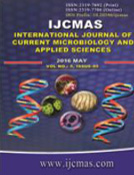


 National Academy of Agricultural Sciences (NAAS)
National Academy of Agricultural Sciences (NAAS)

|
PRINT ISSN : 2319-7692
Online ISSN : 2319-7706 Issues : 12 per year Publisher : Excellent Publishers Email : editorijcmas@gmail.com / submit@ijcmas.com Editor-in-chief: Dr.M.Prakash Index Copernicus ICV 2018: 95.39 NAAS RATING 2020: 5.38 |
Seabirds such as Larus dominicanus are very vulnerable to contaminants and pathogens and can be used to reflect changes in the health of marine ecosystem. The objective of this study was to identify pathogenic bacteria associated with the Kelp Gulls on the coast of Santa Catarina. Monthly campaigns were made on three coastal islands, where cloacal samples were taken from young gulls and used for microbiota identification. In the laboratory the samples were analyzed, targeting species gram-negative (genus Salmonella) and gram-positive (genus Staphylococcus). Through specific biochemical tests were identified 23 species. The Kruskall-Wallis test (H = 74,914; n = 33; p < 0,05) indicated significant differences among the islands applied to number of isolated strains per specie. Tamboretes Island presented higher diversity (2.36) of bacteria, followed by Moleques do Sul (2.10) and Lobos Islands (1.35). Moleques do Sul had the highest richness value (2.87), followed by Tamboretes (2.55) and Lobos (1.14). The equitability was higher for Tamboretes (0.92), followed by Moleques do Sul (0.79) and Lobos (0.51). Greater similarity between Tamboretes and Moleques do Sul was observed by Jaccard. However Bray-Curtis indicated greatest association between Lobos and Tamboretes. The results suggest that pathogenic bacteria are associated with young gulls.
 |
 |
 |
 |
 |